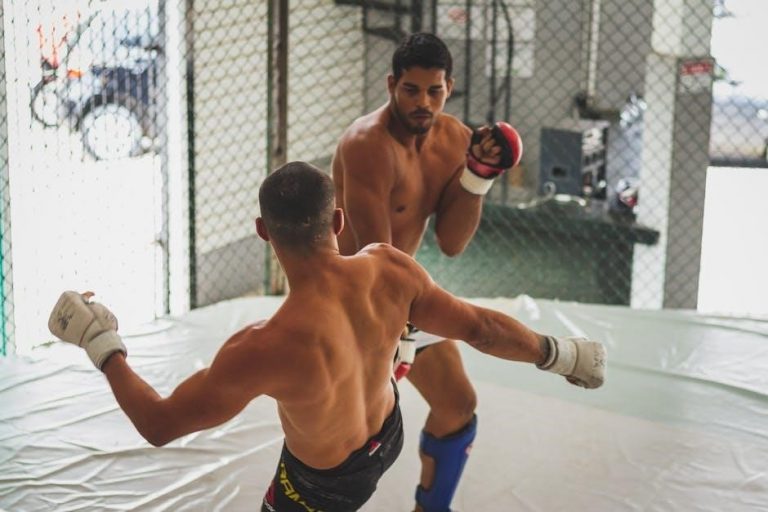
Muay Thai workout routines offer a holistic approach to fitness, combining strength, endurance, and technique. Structured plans enhance physical and mental discipline, perfect for beginners and professionals.
1.1 What is Muay Thai?
Muay Thai is Thailand’s national sport, a combat discipline emphasizing powerful strikes and clinching techniques. Known as the “Art of Eight Limbs,” it integrates fists, elbows, knees, and shins. This full-body workout enhances strength, endurance, and agility. Practiced for both combat and fitness, Muay Thai fosters mental resilience and discipline.
1.2 Benefits of a Muay Thai Workout
A Muay Thai workout boosts cardiovascular health, burns calories, and builds lean muscle. It improves coordination and reflexes while enhancing mental focus and stress relief. The discipline fosters self-confidence and overall well-being, making it a comprehensive fitness choice for all skill levels.
1.3 Importance of a Structured Routine
A structured Muay Thai routine ensures efficient training, progressive overload, and balanced development of endurance, strength, and technique. It helps track progress, maintains consistency, and prevents overtraining. A well-planned routine allows fighters to adapt to demands, set clear goals, and achieve optimal performance. This organization is key for both beginners and advanced practitioners, fostering discipline and maximizing results in physical fitness and combat skills. Consistency in following a structured plan enhances overall progress and mastery of Muay Thai techniques effectively.
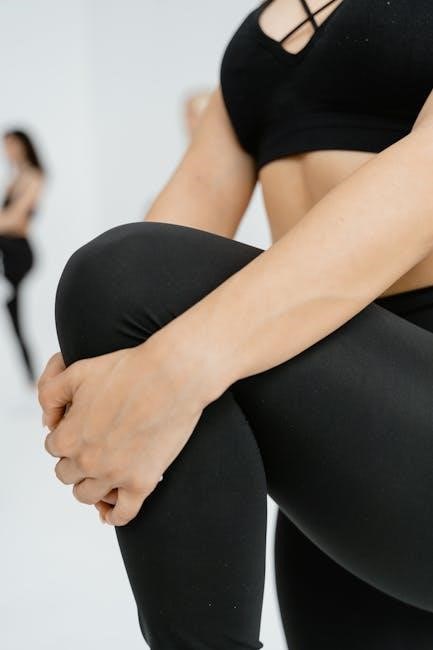
Components of a Muay Thai Workout Routine
Muay Thai workouts integrate warm-ups, technique drills, conditioning, strength training, sparring, and cool-downs. These components build endurance, power, and skill, ensuring a well-rounded fitness regimen.
2.1 Warm-Up and Mobility Exercises
A proper warm-up is essential for Muay Thai training, preparing the body for intense physical activity. It typically includes dynamic stretching, shadowboxing, and joint mobilization to enhance flexibility and range of motion. Mobility exercises, such as leg swings and arm circles, improve coordination and reduce injury risk. A 15-20 minute routine is recommended, gradually increasing heart rate and loosening muscles. This foundational step ensures athletes are ready to perform at their best during the workout.
2.2 Technique Drills (Punches, Kicks, Elbows, Knees)
Mastering Muay Thai techniques requires focused drills to improve precision and power. Punches include jabs, hooks, and uppercuts, while kicks involve roundhouse and front kicks. Elbows and knees are practiced for close-range strikes. Drills are often performed with pads or heavy bags to refine form and balance. Emphasizing proper stance and movement ensures effective execution. These exercises build coordination, timing, and overall combat readiness, forming the foundation of a Muay Thai workout routine.
2.3 Conditioning and Endurance Training
Conditioning and endurance are crucial for sustaining energy during Muay Thai fights. High-intensity interval training (HIIT), shadow boxing, and bag work are common methods to improve cardiovascular fitness. Battle ropes, jump ropes, and hill sprints enhance stamina and coordination. These exercises simulate fight scenarios, building the endurance needed for prolonged rounds. Incorporating core exercises like planks and sit-ups strengthens the midsection, essential for powerful strikes and defensive movements. A well-structured conditioning plan ensures fighters maintain peak performance throughout training and competition.
2.4 Strength Training
Strength training is essential for Muay Thai, enhancing power and overall performance. Focus on functional exercises like push-ups, pull-ups, and weighted drills to build muscle endurance. Squats, lunges, and deadlifts target the legs, while medicine ball throws and resistance band work improve core and upper body strength. These exercises are designed to mimic fight movements, ensuring transitions between techniques are explosive and efficient. A strong foundation allows fighters to deliver powerful strikes and maintain dominance in the ring.
2.5 Sparring and Pad Work
Sparring and pad work are dynamic sessions that simulate real fight scenarios, enhancing timing, reflexes, and technique application. Sparring allows practitioners to test their skills against opponents, improving adaptability and combat instincts. Pad work, conducted with a partner or coach, focuses on precision, speed, and power, drilling combinations of punches, kicks, and elbows. These sessions build mental toughness and reaction skills, ensuring techniques are battle-ready. Proper safety gear and controlled intensity are crucial to maximize benefits while minimizing injury risks.
2.6 Cool Down and Recovery
A proper cool down after Muay Thai training is essential for reducing muscle soreness and promoting recovery. Static stretching focuses on improving flexibility, particularly in the hamstrings, hips, and shoulders. Gentle cardio, such as light jogging or jumping rope, helps lower heart rate gradually. Foam rolling and self-myofascial release target tight muscles, enhancing blood flow. Breathing exercises calm the mind and body, transitioning smoothly from intense physical activity to a resting state. Recovery practices ensure the body is prepared for the next workout.
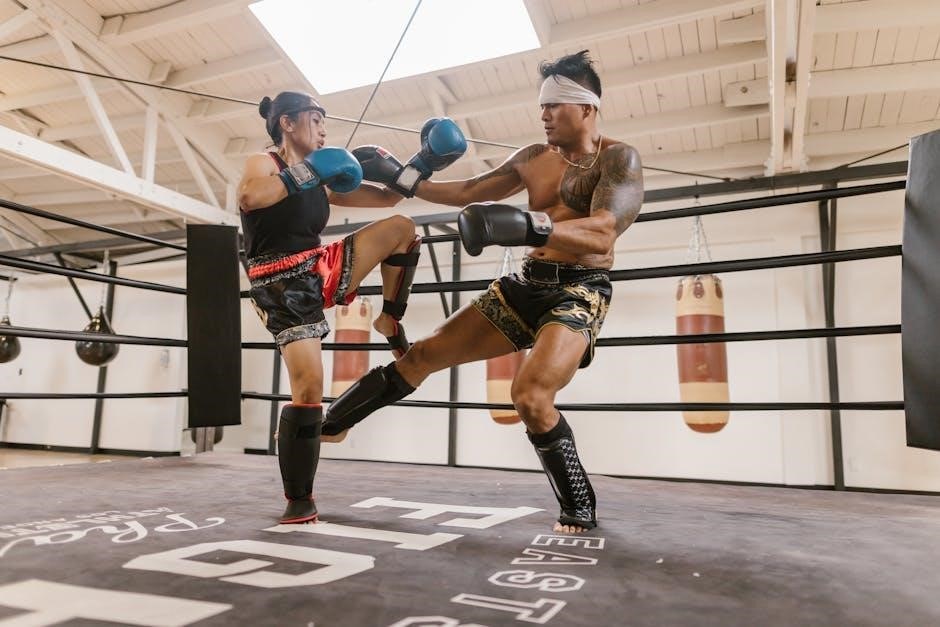
Weekly Workout Plan Overview
A structured seven-day routine balances technique, strength, endurance, and recovery. Each day focuses on specific skills, ensuring comprehensive development and peak physical conditioning for Muay Thai training.
3.1 Day 1: Technique Focus
This day emphasizes mastering fundamental Muay Thai techniques. Start with shadowboxing to refine punches, kicks, and defensive movements. Follow with heavy bag drills focusing on precise strikes and combinations. Pad work with a partner or coach is next, emphasizing timing and accuracy. Finish with clinch practice to improve close-range control and positioning. Each exercise is performed in 3-5 rounds, with short breaks, ensuring proper form and technique are prioritized over speed and power.
3.2 Day 2: Strength and Conditioning
Day 2 focuses on building strength and endurance. Begin with weight training, targeting lower body strength through squats and lunges. Incorporate plyometric exercises like jump squats for explosive power. Bodyweight exercises such as push-ups and planks strengthen the upper body and core. Finish with high-intensity interval training (HIIT) using battle ropes and kettlebells. Each exercise is performed in 3-4 sets with minimal rest to boost cardiovascular endurance and muscular stamina, essential for Muay Thai performance.
3.3 Day 3: Endurance and Cardio
Day 3 emphasizes endurance and cardiovascular fitness. Start with a 10-minute dynamic warm-up, followed by 20 minutes of steady-state cardio, such as jogging or cycling. Incorporate high-intensity interval training (HIIT) with exercises like jump rope, burpees, and mountain climbers. Finish with 10 minutes of cool-down stretching. This routine improves stamina, enhances heart rate recovery, and builds the endurance needed for prolonged Muay Thai rounds, ensuring sustained energy levels during intense training sessions.
3.4 Day 4: Sparring and Pad Work
Day 4 focuses on sparring and pad work to refine technique and simulate real fight scenarios. Begin with a 10-minute warm-up, then engage in 5 rounds of controlled sparring, emphasizing defensive and offensive maneuvers. Transition to 3 rounds of pad work, incorporating combinations of punches, kicks, elbows, and knees. Finish with 10 minutes of cool-down stretching. This session enhances timing, footwork, and overall fight readiness, while improving coordination and reflexes under pressure.
3.5 Day 5: Active Recovery
Day 5 focuses on active recovery to allow your body to heal while maintaining mobility. Begin with light cardio, such as jogging or cycling, followed by dynamic stretching and yoga. Incorporate foam rolling and self-myofascial release to reduce muscle tension. Engage in gentle mobility exercises, such as shadow boxing or flowing techniques, to promote flexibility and relaxation. Avoid high-intensity activities to ensure proper recovery and preparation for the next training phase.
3;6 Day 6: Full Workout Integration
Day 6 combines all elements of Muay Thai training into a comprehensive session. Begin with dynamic warm-ups and mobility exercises, followed by technique drills focusing on punches, kicks, elbows, and knees. Engage in sparring or pad work to apply techniques in real-time scenarios. Incorporate heavy bag exercises for power and endurance. Finish with conditioning exercises like jump rope or sprints. Conclude with a cool-down session, including stretching and foam rolling to promote recovery and prepare for the final rest day.
3.7 Day 7: Rest and Recovery
Day 7 focuses on rest and recovery to allow your body to heal and adapt. Engage in light activities like yoga or stretching to improve flexibility. Use foam rolling or massage to reduce muscle tension. Ensure adequate hydration and nutrition to replenish energy stores. Prioritize quality sleep to support muscle repair and mental rejuvenation. Avoid strenuous activities to prevent overtraining and maintain long-term progress in your Muay Thai journey.

Advanced Training Techniques
Advanced Muay Thai techniques enhance performance through plyometric exercises, core strengthening, agility drills, and functional training, ensuring efficient and effective workouts for seasoned practitioners.
4.1 Plyometric Exercises for Power
Plyometric exercises, such as box jumps and burpees, are essential for developing explosive power in Muay Thai. These movements enhance muscle reactivity and speed, crucial for powerful strikes and quick movements in the ring. Incorporating plyometrics into your routine improves overall athleticism and fight performance, making them a key component of advanced training regimens for Muay Thai practitioners aiming to elevate their skills and stamina.
4.2 Core Strengthening for Stability
Core strengthening is vital for stability and balance in Muay Thai. Exercises like planks, Russian twists, and leg raises target abdominal and oblique muscles, enhancing rotational power and defense. A strong core improves posture, reduces injury risk, and maximizes striking efficiency. Incorporating core workouts into your routine ensures better overall stability, allowing for more effective techniques and endurance during intense training sessions and fights.
4.3 Agility Drills for Speed

Agility drills are essential for improving speed and quickness in Muay Thai. Ladder drills, cone exercises, and plyometric movements enhance footwork, acceleration, and directional changes. These exercises simulate ring movements, boosting overall agility and reaction time. By incorporating agility training into your routine, you’ll develop the speed and precision needed for effective strikes and evasive maneuvers during fights, giving you a competitive edge in the ring.
4.4 Functional Training for Practical Application
Functional training in Muay Thai focuses on exercises that mimic real fight scenarios, enhancing practical skills. Medicine ball throws, resistance band work, and battle ropes improve coordination and striking power. Tire sledgehammer swings and sandbag carries build endurance and functional strength. These drills bridge the gap between gym workouts and actual combat, ensuring that every movement translates to effective techniques in the ring, making training more purposeful and applicable to real fights.
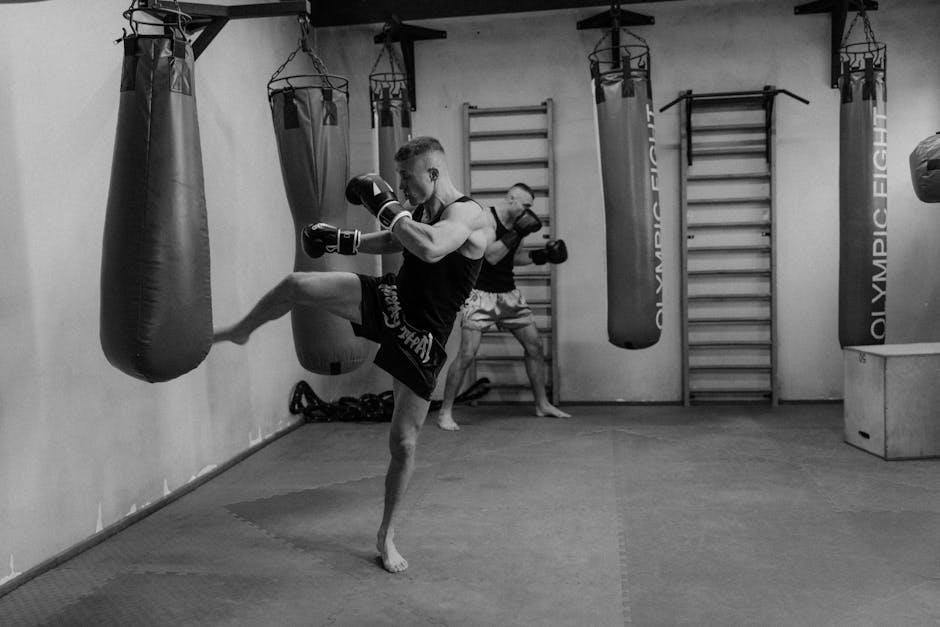
Nutrition and Recovery for Muay Thai
Proper nutrition and recovery are crucial for Muay Thai. A balanced diet, hydration, electrolyte balance, adequate sleep, and foam rolling ensure optimal performance, muscle repair, and injury prevention.
5.1 Diet and Meal Planning
A well-structured diet is essential for Muay Thai athletes. Focus on protein-rich foods like lean meats and fish, complex carbs from whole grains, and healthy fats from avocados and nuts. Hydration is key, with electrolyte balance maintained through coconut water or sports drinks. Meal timing should align with training sessions to optimize energy levels and recovery. Avoid processed foods and sugars to prevent energy crashes and support overall performance.
5.2 Hydration and Electrolyte Balance
Proper hydration and electrolyte balance are crucial for Muay Thai performance. Water and electrolyte-rich beverages like coconut water or sports drinks help maintain fluid balance and prevent dehydration. Electrolytes, such as sodium and potassium, are lost through sweat and must be replenished to avoid muscle cramps and fatigue. Aim to drink water regularly before, during, and after training sessions, and monitor urine color to ensure optimal hydration levels for peak performance and recovery.
5.3 Sleep and Rest Strategies
Sufficient sleep and rest are vital for recovery and performance in Muay Thai. Aim for 7-9 hours of quality sleep nightly to support muscle recovery and mental clarity. Incorporate rest days to allow your body to heal and rebuild. Consistency in sleep schedules and creating a relaxing bedtime routine can enhance sleep quality. Prioritizing rest ensures optimal physical and mental preparedness for intense training sessions and competitions, making it a cornerstone of a successful Muay Thai workout routine.

5.4 Foam Rolling and Stretching
Foam rolling and stretching are essential for muscle recovery and flexibility in Muay Thai training. These practices reduce muscle soreness, improve circulation, and enhance range of motion. Focus on key areas like the IT band, hamstrings, and shoulders. Incorporate dynamic stretches before workouts and static stretches post-session. Regular foam rolling helps break down scar tissue, promoting better mobility. These routines support long-term injury prevention and ensure optimal performance during intense Muay Thai sessions, making them a vital part of any training regimen.
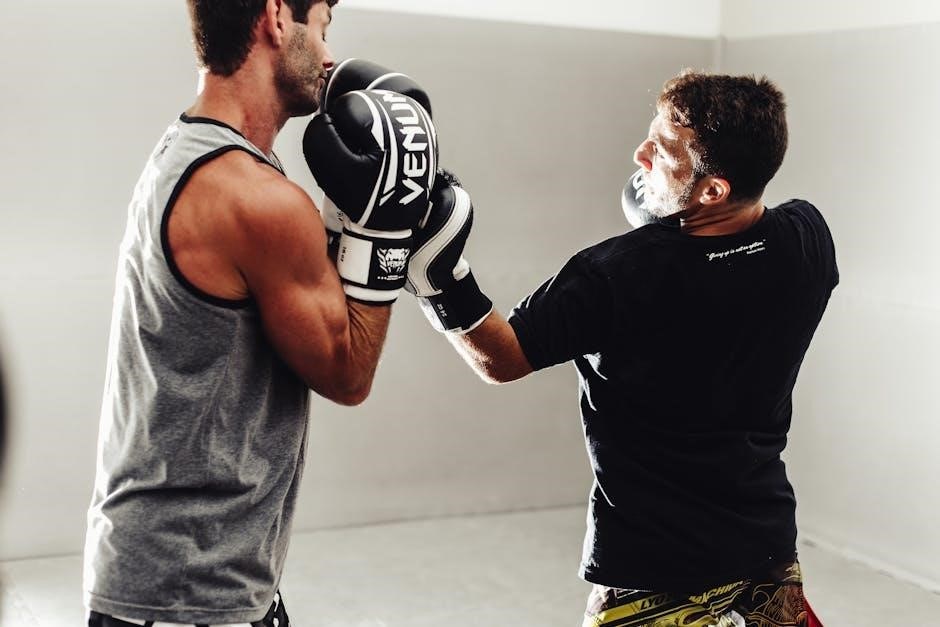
Creating a Muay Thai Workout PDF Guide
A well-structured Muay Thai workout PDF guide includes detailed drills, techniques, and progress tracking. Visual aids and clear instructions ensure effective training for fighters and fitness enthusiasts alike.
6.1 Structuring the PDF
Structuring a Muay Thai workout PDF guide involves organizing content logically for easy navigation. Start with an introduction, followed by weekly workout plans, technique breakdowns, and nutrition advice. Include visual aids like diagrams and images to illustrate drills and exercises. Dedicate sections for warm-ups, strength training, and recovery. Add progress tracking sheets to monitor improvements. Ensure each section is clearly labeled and hyperlinked for quick access. This structure makes the guide user-friendly and comprehensive for both beginners and advanced practitioners.
6.2 Including Visual Aids and Diagrams
Visual aids like images, diagrams, and infographics enhance the clarity of a Muay Thai workout PDF. Technique illustrations help practitioners master moves, while workout flowcharts provide a clear routine structure. Include diagrams of equipment setups, proper stances, and striking techniques. Use anatomy charts to highlight muscle groups targeted during exercises. Progress tracking charts allow users to monitor their improvements. High-quality images of drills and exercises ensure proper form and execution, making the guide more engaging and user-friendly for all skill levels.
6.3 Adding Progress Tracking Sheets
Incorporating progress tracking sheets in your Muay Thai workout PDF helps users monitor their advancements. Include sections for logging workout completion, weight changes, and technique mastery. Add fields for noting improvements in speed, endurance, and strength. Provide charts for tracking weekly goals and achievements. This feature not only enhances accountability but also motivates users by visualizing their progress. Ensure the sheets are easy to update digitally or print for manual use, making the guide practical and user-friendly.
6.4 Benefits of a Digital Workout Guide
A digital Muay Thai workout guide offers unmatched accessibility and convenience. Users can access routines anytime, anywhere, without physical storage constraints. Digital formats allow for easy updates, ensuring the latest techniques are always included. Interactive features like video tutorials and progress tracking enhance user engagement. Sharing and printing specific sections simplify planning. Additionally, digital guides reduce environmental impact, making them a sustainable choice for fitness enthusiasts. This modern approach caters to today’s tech-savvy generation, providing a seamless training experience.
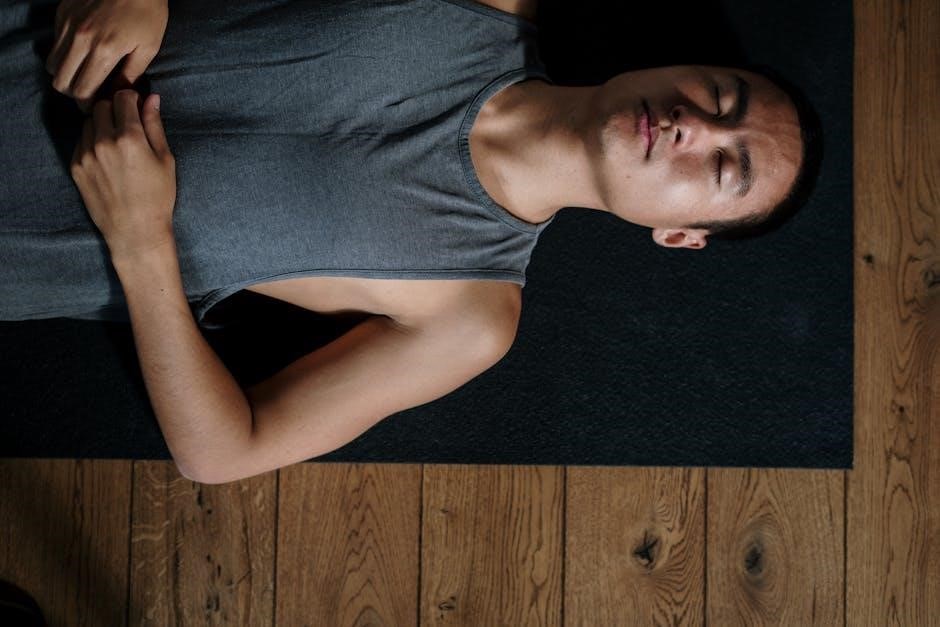
Safety and Injury Prevention
Proper gear, warm-ups, and cool downs are essential for injury prevention. Listen to your body to avoid overtraining. Prevent common injuries like sprains and strains with correct form and rest.
7.1 Proper Gear and Equipment
Essential gear includes hand wraps, gloves, mouthguards, and shin guards to protect against injuries. Proper equipment ensures safety during intense training sessions. Invest in high-quality gear to prevent bruises, fractures, and dental injuries. Wearing the right attire, such as comfortable shorts and a tank top, also enhances mobility. Skipping gear can lead to severe injuries, making it crucial to prioritize protection. Quality equipment not only safeguards but also supports optimal performance during Muay Thai workouts.
7.2 Warming Up and Cooling Down
A proper warm-up prepares the body for intense training, reducing injury risk and improving performance. Dynamic stretches, light cardio, and joint mobilization are essential. Cooling down with static stretches and foam rolling aids muscle recovery, preventing soreness. Neglecting these steps can lead to injuries and prolonged recovery times. Consistent warm-up and cool-down routines are vital for long-term progress in Muay Thai, ensuring both safety and effectiveness in every session.
7.3 Listening to Your Body
Listening to your body is crucial in Muay Thai training to avoid overtraining and prevent injuries. Rest and recovery are as important as intense workouts. Ignoring signs of fatigue or pain can lead to long-term damage. Pay attention to your limits and adjust your routine accordingly. Quality of training outweighs quantity, ensuring sustainable progress and overall well-being. By honoring your body’s signals, you maintain peak performance and reduce the risk of burnout or injury.
7.4 Common Injuries and Prevention Tips
Muay Thai training often leads to injuries like bruises, sprains, and fractures, particularly in hands, wrists, and shins. To prevent these, wear proper gear such as hand wraps, gloves, mouthguards, and shin guards. Always warm up and cool down thoroughly, and focus on correct technique. Avoid overtraining and listen to your body to prevent muscle strains. Incorporate stretching and strength exercises to improve flexibility and joint stability. Proper conditioning and rest can significantly reduce the risk of injury during training.

Embrace the transformative power of Muay Thai workouts! Start your journey with structured routines, track progress, and stay consistent. Empower your body and mind for lifelong fitness.
8.1 Recap of Key Points
Muay Thai workout routines blend technique, conditioning, and strength for a comprehensive fitness regimen. Structured plans enhance endurance, coordination, and mental discipline. Proper nutrition, recovery, and safety are crucial. Regular practice and consistency yield transformative results. Use the provided PDF guide to track progress and stay motivated. Embrace the journey, and let Muay Thai empower your body and mind for lifelong wellness and self-improvement.
8.2 Encouragement to Start Training
Embark on your Muay Thai journey with confidence! This workout routine is designed to challenge and transform your body and mind. Whether you’re a beginner or an experienced athlete, Muay Thai offers a rewarding path to physical and mental growth. With dedication, you’ll build strength, endurance, and discipline. The structured PDF guide ensures a clear roadmap, making it easy to stay consistent. Join the Muay Thai community and embrace the transformative power of this ancient martial art for a stronger, healthier you.
8.3 Resources for Further Learning
Enhance your Muay Thai journey with these resources! Official federation websites offer training guides and expert tips. Instructional DVDs and YouTube channels provide visual learning. Books by experienced practitioners share in-depth techniques. Fitness apps track progress and offer guided workouts. Local gyms with certified instructors ensure proper form and safety. Online forums and communities connect you with fellow practitioners for support and advice. These tools will deepen your understanding and keep you motivated on your Muay Thai path.
